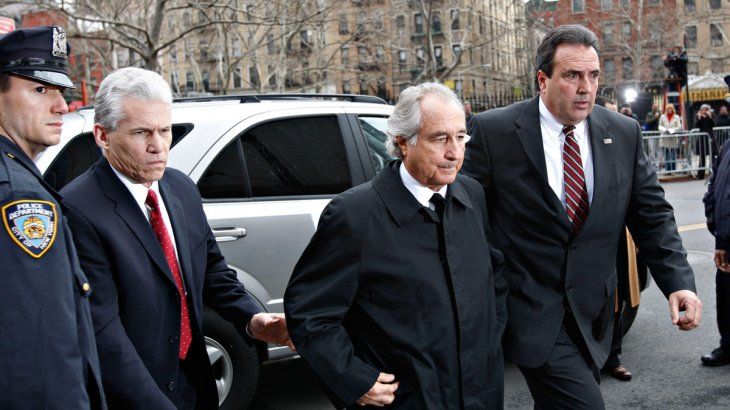the best known
Carlo Pietro Giovanni Guglielmo Tebaldo Ponzi was born in Lugo (Italy) 140 years ago. The pyramid scheme he organized was not the first of its kind, but it was the best known. In fact, his last name gained such a level of public notoriety that from then on all scams of this type were renamed “Ponzi”.
In 1919, the Italian started his scam. It raised funds from investors and offered a 50% return in 90 days. Not bad, right? Word spread quickly and more and more investors came knocking on the door of the Ponzi company to place their savings. The so much upped the ante and began offering a 50% return in 45 days, in order to capture more and more money.
In fact, the boston post took out a front-page note saying “DOUBLE YOUR MONEY IN THREE MONTHS,” encouraging people to put their savings there. As expected, his name caught the attention of the authorities, who began to investigate him. Beyond the charisma of the Italian and his various attempts to calm the waters, the audit he underwent shed light on the matter: Carlito was insolvent.
Ponzi was brought to trial and sentenced to 5 years in prison, but after serving 3 and a half years he was released. In 1925, he was again prosecuted by the state of Massachusetts for fraud. He was convicted, appealed, and was paroled. He took the opportunity to go to Florida, where he was given to selling swamp land. The result? Convicted of fraud. You don’t learn, do you?
America has many states and Ponzi was already doomed in two. His solution was to go to Texas, where he joined an Italian ship. However, they arrested him in New Orleans and sent him back to Massachusetts to serve his sentence in the Charlestown jail.
1934 came and Ponzi was finally released. Remaining bald and with 20 kilos more, the Italian was waiting for him with a deportation order. He had never become a US citizen and logically his criminal record did not help him stay. He had to go to Italy.
From there, there are two versions of what happened to him: a brand that became a high-ranking minister for Mussolini’s government, until they realized that he did not know much about finances. Another version states that a relative put him to work in an Italian airline to do business between Brazil and Italy, a position he held until the United States joined World War II.
Be that as it may, both paths led him to emigrate to Brazil. There, dilapidated and ostracized, he worked teaching English and French before joining an Italian firm, where he worked as an interpreter.
In 1948, a brain hemorrhage left him paralyzed in half his body. By this time, he was beginning to show symptoms of blindness. On January 18, 1949, in a humble hospital in Rio de Janeiro, he died. He left a debt of 75 dollars to pay for his funeral. He was 66 years old.
ponzi.jpg
the pioneer
Ponzi was the best known, but it was not the first. In 1899, William F Miller he was barely 25 years old. By then, the young Brooklynite had set up the Franklin Syndicateconvincing three friends to give him money to invest in the Stock Market.
The good Bill earned the nickname “520%”, since he offered 10% weekly (WEEKLY) profit to those who invested with him, claiming that he had inside information about what would happen to listed companies. He expanded and spent $32,000 (today it would be almost 1 million) to promote himself in around 800 newspapers.
He came to have 13,000 investors and the peculiar thing is that he only invested once in the Stock Market: he transformed US$1,000 into US$5.60 in a few days (-99.44%, it seems that he did not read the doctor in “trading ”).
The thing is, sometimes scammers get scammed, and that’s the case with “Honest Bill,” as he was known during his time in jail. Bill was contacted by Robert Ammon, a lawyer who realized that “520%” was not legal. When Miller found himself cornered by the police, Ammon convinced him to keep the money raised in his own bank accounts and offered him safe conduct to Montreal, Canada. Miller agreed, giving him a total of $250,000.
He left his wife and daughter in NYC and ran away. However, the New York Police found him and brought him back. Trial and 10 years sentence. And Ammond? He bought Miller’s silence for $5 a week that he gave to his wife and daughter. Without his cooperation, the lawyer would never go to jail.
Finally, Miller testified and Ammon was sentenced, although only for four years. He left and was never heard from again. On Miller’s side, he was released after six years but in poor health due to tuberculosis that was terminal at the time.
The largest
madoff.jpg

If you are going to start a financial advisory company, it is probably not convenient for you to name it Madoff. It is that during two decades of lies, Bernard Madoff He took it upon himself to dirty his surname and that of his family forever.
Born in NYC in 1938, he became the NASDAQ’s chief coordinator! but he ultimately ended up scamming his investors out of around $20 billion (it was always said to be $65,000, but in reality the difference was Bernie’s made-up profit). His story is more than well known and in fact Robert de Niro came to personify it in The Wizard of Liesa biopic about his life.
Finally, in 2008 he was arrested and three months later he pleaded guilty. How much did they give him? 150 years. His scams not only got him jailed for life but also led to the suicide of his son Mark, exactly two years after his father’s arrest.
Madoff never recovered from that fact and stated that he woke up very early in the morning because of the guilt he felt after the death of his son. In 2020, at the age of 82, he asked to be released for having terminal cancer. His request was denied and in 2021 he passed away in prison.
The Latin American background
Jose Javier Cabrera Roman He worked as a notary and earned US$492 per month. In 2005, he was found dead in a 5-star hotel in Quito, Ecuador. He came to manage US $ 800 million, being the second largest “bank” in the country behind Banco de Pichincha. Although the records indicate that it had 30,000 clients, unofficially it is said that 200,000 were affected during the 13 years in which it carried out its operations. It offered between 7 and 12% monthly interest.
The cause of death indicated a heart attack, product of a cocktail of cocaine and whiskey. She was 71 years old. The complicated part began when he learned of his death in Machala, the city that was his center of operations.
It’s just that good old José Javier had many military and police officers among his clients, as well as judges and politicians. Faced with this situation, the military raided Cabrera’s offices and stole around US$40 million. Of course, the situation did not sit well with the rest of the population who also wanted to get their money back.
Two Air Force planes and even the presidential plane were sent to rescue the military who had broken into the scammer’s offices. The population couldn’t take it anymore and a horde of locals went to the cemetery to desecrate Cabrera’s grave. Finally, the body was exhumed twice and it was found that the body belonged to the notary. After knowing what happened, his children had to leave the country after announcing that they would continue with the business and would recognize the money to the victims. It still hasn’t happened.
The one who still lives
allen standford

Of all the swindlers, there is one who still lives: Allen Stanford. Born in Texas 72 years ago, he defrauded more than 30,000 clients worldwide with a scheme involving certificates of deposit issued by Stanford International Bank, based on the island of Antigua and Barbuda.
The SEC began to investigate him for the high interest rates he offered and ended up finding a network between authorities of the Caribbean island and Stanford. For this, James Davis (financial chief of Stanford Bank) was key in his testimony, both beforehand and in the trial.
Stanford went from one year to the next from being on the Forbes list of millionaires with $2.2 billion to being in jail. The accusation was for US$ 7,000 million and the sentence was clear: 110 years in prison. In his plea, the scammer explained that the US government had ruined his business and that Stanford was a real global financial empire. The delusion is complete.
He is a prisoner in the Coleman II prison in Florida and would be released on 03/13/2103. At that time, he would be 149 years old.
As we can see, the convictions for these crimes have increased in scope and duration over the years. Although it is true that the charges that Cositorto would face do not suggest that he will spend 100 years in prison, it is a good opportunity for justice to give an exemplary sentence. The only certainty is that easy money does not exist and that high returns carry a very high risk.
A fact of color, to take into account. It seems that the first quarter of the year and scammers are correlated. Ponzi was born in March and passed away in January. Madoff was born in April and passed away in April. Stanford was born in March. And Cositorto, was born in April. Regarding them, you have to believe or burst. And there is something that surely should not be done: invest.
Source: Ambito




